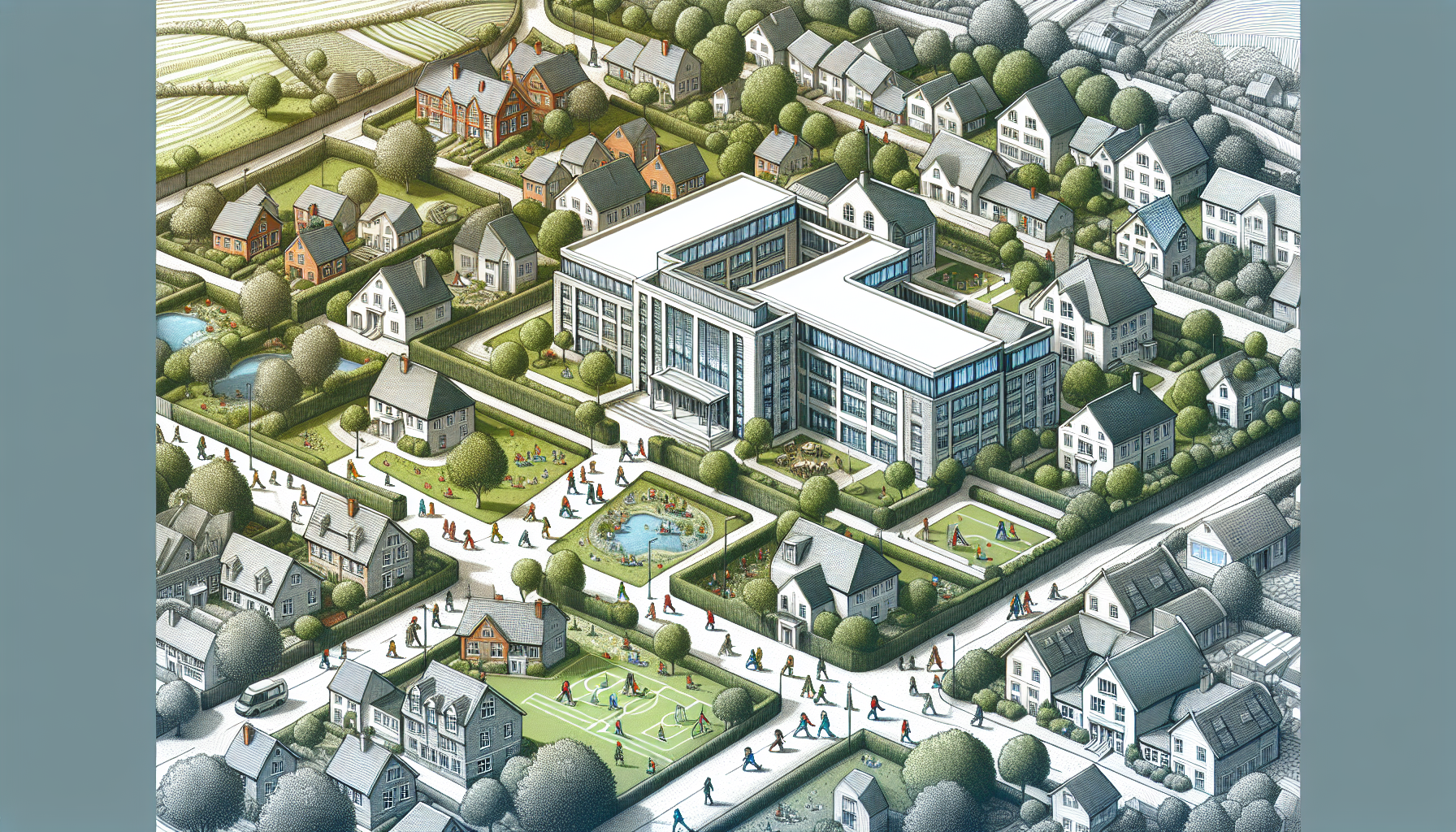What sets community schools apart in the educational landscape? Centered on collaborative partnerships and well-rounded services, community schools offer more than just academics; they’re about nurturing students in a supportive, inclusive environment. This article delves into the heart of community schools, presenting how they operate, their benefits, and their role in community engagement, without spoiling the depth of content to come.
Key Takeaways
- Community schools enhance holistic student development, involve family and community engagement, and improve academic outcomes with comprehensive support services and expanded learning opportunities.
- A collaborative ecosystem involving administrators, teachers, support staff, and the pivotal role of community school coordinators aligns resources with student needs for effective education and community partnerships.
- Community schools apply innovative programs and professional development, embrace diversity and equity, and foster a positive, inclusive school culture with restorative practices to prepare students for successful futures.
Understanding the Community School Model

The community school approach is more than a mere educational framework. It embodies a dynamic and robust methodology that infuses schooling with vigor. In regions such as California, the establishment of community schools has manifested an ambition wherein education techniques and support services merge to foster all-encompassing growth in students. These institutions are not self-contained, but rather integrate the participation of both families and local individuals, broadening the scope of their impact to include not just those enrolled.
In these environments, educators, administrative personnel, and auxiliary staff serve as critical pillars by collaboratively pinpointing and responding to varied student necessities through joint governance and thorough evaluation of needs. It is this collective effort which differentiates the model from conventional public education paradigms—by cultivating healthier communities where enhanced learning outcomes for pupils can flourish.
The Four Pillars of Community Schools
Central to the community school strategy are four foundational elements that support its mission. The initial element, integrated student supports, is about strategically utilizing community assets within the educational setting to address various obstacles impeding students’ academic achievements. Next in line is expanded and enriched learning time and opportunities which bestow extra hours upon learners for both scholarly pursuits and extracurricular activities, thus broadening their educational journey.
These pillars encompass:
- Integrated student supports
- Expanded and enriched learning time and opportunities
- Active family and community engagement
- Cooperative leadership structures
When combined, these principles forge a robust framework crucial for fostering not only the triumphs of students but also cultivating healthy climates in schools adopting the community school approach.
Role of the Community School Coordinator
The role of the community school coordinator encompasses:
- Managing and harmonizing the plethora of resources available at the school.
- Tailoring these resources to address students’ specific needs.
- Serving as a pivotal point for enhancing educational achievements.
- Coordinating an elaborate network that includes service providers, county agencies, and nonprofits.
Their persistent work is vital in ensuring that schools maximize their available assets and alliances.
Throughout key stages such as planning and execution, community school coordinators are instrumental in catalyzing engagement. They drive participation among all parties involved—from families to community partners—in furtherance of the robust principles inherent within the community schools model. Their central function guarantees seamless functioning within this framework, allowing every element to play its part efficaciously for the welfare of those within the school’s sphere.
Must Read : Online Medical Assistant Degree: 5 Free Expert Tips to Get Started
Advantages Over Traditional Public Education Models
Adopting the community school model in place of traditional models within public education brings with it a plethora of vital advantages that warrant attention. Notably, this approach results in the establishment of more nurturing environments within schools by adopting restorative methods instead of strict zero tolerance policies. Such strategies lead to a decrease in student arrests and suspensions, consequently building up a sense of well-being and fostering greater fairness among members of the school community.
Integrating School-Based Health Centers (SBHCs) into community schools has proven revolutionary by:
- reducing instances of absenteeism
- enriching the overall atmosphere at school
- proving behavior amongst students
- yielding improved academic performance
The implementation is indicative not just of an advanced public education method but one replete with sophisticated knowledge tailored for crafting communities that are both healthier and better educated—embodying why such transformative approaches in public education stand out as profound milestones.
The Synergy of School and Community

The union of community members and schools forms a potent alliance that enhances the traditional academic setting. Partnerships between the school community and its surrounding residents not only elevate educational pathways but also strengthen bonds with the local populace. These connections enable schools to work alongside family and community members, bringing forth an array of additional activities and support services that contribute positively to student development.
Community school partnerships allow for:
- Integrating lessons taught within classrooms with real-life issues present in the local neighborhood
- Offering students hands-on learning experiences which are both pertinent and stimulating
- Promoting a collective sense of accountability for ensuring student success
- Building an expansive network of support that goes well beyond just scholastic environments
Such a mutually beneficial relationship among students, their families, and other citizens results in shared responsibilities toward fostering student achievement while establishing a network comprised of those from inside as well as outside the boundaries defined by academia.
Collaboration with Community Partners
The joint effort between community schools and regional partners underscores the dedication of these educational models to furnish a full array of services and resources. By collaborating with a multitude of entities and providers, community schools amplify their capabilities to address the comprehensive needs of students. The range of services and supports offered through such partnerships include academic enhancement programs, behavioral interventions, medical care, as well as social service support.
This approach equips the school with an extensive system designed to bolster student success.
As a stellar representation of this cooperative dynamic, some schools have set up on-site health centers by joining forces with local healthcare organizations. These facilities deliver all-encompassing health services that are critical for maintaining student health. Exemplifying collaborative innovation are initiatives like Multi-Tiered Systems of Support (MTSS) and Coordination of Services Team (COST). Such strategies fine-tune how different forms of assistance are provided within the school environment, which leads to more effective resource utilization. It’s through collective leadership efforts like these that allow community schools not only to engage effectively with educational institutions but also form strategic alliances across sectors including nonprofit agencies alongside municipal governance bodies—all aiming at servicing varied aspects pertaining to their students’ welfare.
Impact on Students and Families
Community schools significantly impact the well-being and growth of students and their families, leading to notable improvements in various aspects of development. Establishments that cultivate robust partnerships with local resources and family units often observe an increase in beneficial student outcomes. Active participation from the community within these schools is associated with improved academic success, diminished rates of absenteeism, and higher graduation frequencies.
In California specifically, community schools demonstrate this effect by offering expansive services on campus designed to support a range of needs including academics. Social, emotional, physical, as well as mental health care—all integral components within the framework of a community school initiative. The fusion of educational assistance with mental healthcare offerings has proven particularly powerful. Community engagement is key in enabling such institutions to provide meals along with holistic wraparound services which are vital for advancement according to research from the Annenberg Institute. This approach ensures not only access to necessary health care, but also fosters betterment in both educational achievement and completion figures—especially critical for enhancing outcomes in areas experiencing high levels of poverty.
Academic Excellence through Innovative Programs
Community schools are dedicated to enhancing the educational experience by ensuring that teaching and learning evolve in a manner similar to what is observed in high-performing institutions, with an emphasis on robust academic engagement. Such commitment leads to improvements in student attendance and performance – key indicators of successful educational attainment.
These schools continually strive for greatness, integrating diverse curricula and innovative teaching methods designed to captivate students from all walks of life. This dynamic academic setting fosters an atmosphere where high-quality instruction prevails, equipping learners with essential problem-solving abilities and critical thinking skills crucial for their subsequent pursuits.
Curriculum and Learning Approaches
Educational institutions within community school systems understand that a uniform educational program doesn’t meet the unique needs of their varied student body. They have adopted curricula that are both culturally sustaining and responsive in order to resonate with students from diverse cultural backgrounds. This strategy keeps all students feeling included and motivated. These schools often deliver instructional time that is increased by up to one-third over traditional schedules. This additional time allows for an array of activities including arts education, physical exercise programs, and experiential learning opportunities outside the conventional classroom environment.
In urban areas such as New York City and Boston, numerous school districts’ community schools have embraced expanded academic calendars featuring longer days or extended school years. By doing so, they guarantee ample space for comprehensive participation in both challenging academic offerings and supplementary enrichment pursuits. Such endeavors not only expand upon standard educational content, but also foster an atmosphere where pupils can pursue personal interests while cultivating critical higher-order thinking abilities.
Professional Development for Educators
The importance of ongoing professional development for educators cannot be overstated, particularly within community schools that are pushing the boundaries with their innovative programs. In 2022, a series of webinars were organized by the U.S. Department of Education and its partners to share effective strategies in key areas such as leadership techniques, utilization of data for school improvement, and efficient resource management. The goal was to impart essential skills teachers need in order to tailor curriculum and instructional approaches to accommodate the varying needs of students.
By engaging consistently in professional growth opportunities through such development initiatives, teachers become more adept at evaluating student work effectively, selecting culturally relevant resources for instruction, and integrating restorative discipline practices into their classrooms. This commitment to advancing educator expertise is fundamental in ensuring high-quality teaching which promotes both student success and nurtures an affirmative culture within schools.
Creating a Positive and Inclusive Culture

Community schools are committed to creating an inclusive environment reflective of the Whole School, Whole Community, Whole Child Model. This approach is centered around nurturing students in a safe and supportive atmosphere. It includes implementing strategies that instill community responsibility and address conflict prevention while teaching valuable lessons from behavioral missteps. Restorative justice practices play a pivotal role by reinforcing school culture through focused efforts on establishing positive relationships, promoting social-emotional growth, and facilitating effective conflict resolution.
The influence of this comprehensive model extends into academic programs while simultaneously strengthening bonds between students and educators—creating an educational milieu where mutual respect flourishes. Through these initiatives, community schools don’t just elevate scholastic excellence. They also construct a school culture brimming with inclusivity and empowerment for every student to feel valued within their learning environment.
From Zero Tolerance to Restorative Practices
Shifting from a policy of zero tolerance to the adoption of restorative techniques represents a significant evolution towards an environment that is more nurturing and inclusive in community schools. Schools within California’s communities, for example, have incorporated methods such as restorative practices and positive behavioral interventions into their ethos – critical components in creating a school culture rooted in restoration. These approaches draw on the values inherent to indigenous justice systems, underscoring respect, remediation, and the rallying of the collective to resolve grievances.
Implementing restorative discipline strategies—including:
- Peer mediation
- Community service
- Conversational circles
- Restorative conferences
Provides pupils with viable substitutes for traditional punitive measures like suspension or detention. These methodologies champion conflict resolution through fostering emotional intelligence and strengthening communal ties. They’ve proven instrumental in lowering instances of suspensions among students belonging to racial minority groups thereby promoting fairness within academic settings.
The effectiveness of these initiatives can be seen clearly demonstrated by institutions like Chicago Public Schools, which recorded substantial reductions in both violent incidents and non-violent offenses leading to arrest statistics after implementing similar frameworks.
Embracing Diversity and Equity
Community schools are dedicated to:
- Addressing and rectifying systemic imbalances in education
- Honoring the variety of cultures and identities within their environment
- Engaging with all sectors of the school community on an equitable basis
- Increasing their sensitivity to the needs of those they serve
- Elevating both the standard of education provided and methods of governance
Initiatives focusing on diversity and equity play a significant role by ensuring that safe, supportive learning environments provide equal access to opportunities for students from all backgrounds, particularly for individuals hailing from historically underserved communities.
By wholeheartedly embracing these values centered around diversity and equity, such institutions create a climate where every member is respected. Leadership teams strive collaboratively towards nurturing positive interactions among everyone involved while delivering high-quality teaching practices. It is through this foundational belief system that students become well-prepared citizens capable of engaging successfully in our multicultural world.
Strategies for Success in Community Schools

A number of pivotal strategies are central to the effectiveness of community schools, which have consistently shown improvements in student outcomes. These institutions particularly benefit students who face academic challenges and hail from areas with high poverty levels. Through strategic organization of resources, establishment of collaborative leadership structures, and active engagement with stakeholders, community schools foster an environment that bolsters student success.
In this section, we will delve into the details regarding how resources can be best organized to address the needs of students and how to construct teams that embody leadership collaboration. Such strategies play a crucial role in enabling community schools not only to satisfy their students’ immediate educational requirements, but also establish solid foundations for sustained success and impactful changes within the wider community.
Organizing Resources Around Student Needs
Organizing resources to specifically meet student needs is a vital aspect of community schools. This involves integrating wraparound services into the school’s structure, adhering to the Whole Child tenets, which focus on comprehensive support services. Such wraparound services have been identified as a critical component for improving outcomes in high-poverty schools. To effectively pursue these resources, schools employ a needs and assets mapping process, guiding them in the acquisition of resources and partnerships that address the unique needs of students and families.
This strategic approach to organizing resources ensures that every student has access to the support they need to flourish academically and personally. By holding students accountable and focusing instructional time on foundational and advanced knowledge, community schools are able to tailor their offerings to serve students effectively.
Building Leadership and Collaborative Teams
Effective leadership and team collaboration form the backbone of a successful community school program. In these institutions, leaders are adept at mobilizing resources at local, district, and state levels while actively engaging with stakeholders and utilizing data to refine and enhance their initiatives continuously. Through committees dedicated to leadership and planning that include educators, parents, students, and community partners alike, these schools foster an inclusive environment for shared decision-making.
This collaborative model of governance ensures representation from all involved parties within the school’s ecosystem, ensuring everyone’s perspectives contribute to a unified direction. By adopting this collective approach to both planning as well as execution phases reinforces mutual accountability—a pivotal element for realizing the objectives laid out by the community schools strategy.
Extending Opportunities Beyond the Classroom
Community schools take a comprehensive approach to education, recognizing that true learning extends well beyond traditional academic settings. They offer myriad services tailored to the needs of the whole community. By providing adult education and second language classes, these institutions serve as invaluable resources for students, their families, and members of the local community at large. This broad perspective on educational roles places community schools at the heart of collective growth and empowerment.
These establishments go By incorporating enrichment programs and health services into their offerings, addressing more than just scholastic achievement. These initiatives are designed to promote not only academic excellence but also enhance overall wellness for students, their families, and other community members. In doing so, it helps a lot.
Community schools affirm their role in fostering holistic development while remaining steadfast as an essential pillar within the community framework.
Enrichment Programs and Homework Assistance
Community schools offer a multitude of extended learning opportunities that include enrichment programs and support with homework. The after-school offerings cover a spectrum of activities:
- Assistance with homework
- Tutoring services
- Arts and craft sessions
- Athletic and physical exercises
- Music and dance lessons
- STEM-focused activities
- Exposure to various cultures
These initiatives are crafted to meet the diverse interests and educational requirements of students, reinforcing what is taught during regular school hours. They aim to provide each learner with an opportunity for meaningful engagement in enjoyable educational experiences.
A wide array often fuels these afterschool enrichment community resources including local educators, organizations like the YMCA or Boys & Girls Clubs, as well as online platforms providing access to STEM education. These high-caliber after-school provisions are customized for distinct age groups offering suitable activities aligned with children’s developmental milestones. By incorporating such holistic enrichment strategies, community schools become more than just academic institutions—they serve as nurturing environments where youth can thrive both personally and intellectually.
Health and Wellness Services

In the realm of health and wellness, community schools excel beyond many conventional institutions by offering on-site services that cater to students’ immediate needs. School-based health centers (SBHCs) stand out as a key feature in this model, offering professional clinical care directly within the school environment where students spend most of their day. These facilities are equipped with nurse practitioners, mental health providers, and sometimes physicians who provide primary care, behavioral health services, and dental attention often for minimal or no expense.
The integration of SBHCs into educational settings has been associated with enhanced academic performance and increased graduation rates, highlighting their significance in improving educational prospects. By delivering healthcare through SBHCs on campus grounds, community schools not only contribute to cultivating healthier student bodies but also dismantle learning obstacles—ensuring that learners arrive at school primed and prepared to engage fully in their academics.
Additional Insight
As we conclude our journey through the dynamic world of community schools, it’s clear that these institutions are much more than just schools—they are ecosystems of opportunity, support, and growth. With innovative programs, a focus on holistic development, and a commitment to inclusivity and equity, community schools represent a powerful model for the future of education. By weaving together the strengths of families, educators, and community partners, they create environments where students can flourish both academically and personally.
Let us be inspired by the transformative power of community schools and the myriad ways in which they empower students, families, and communities. May this comprehensive guide serve as a beacon for those seeking to make a positive impact on education and society at large, and may the vision of community schools continue to thrive and expand, illuminating the path to a brighter future for all.

